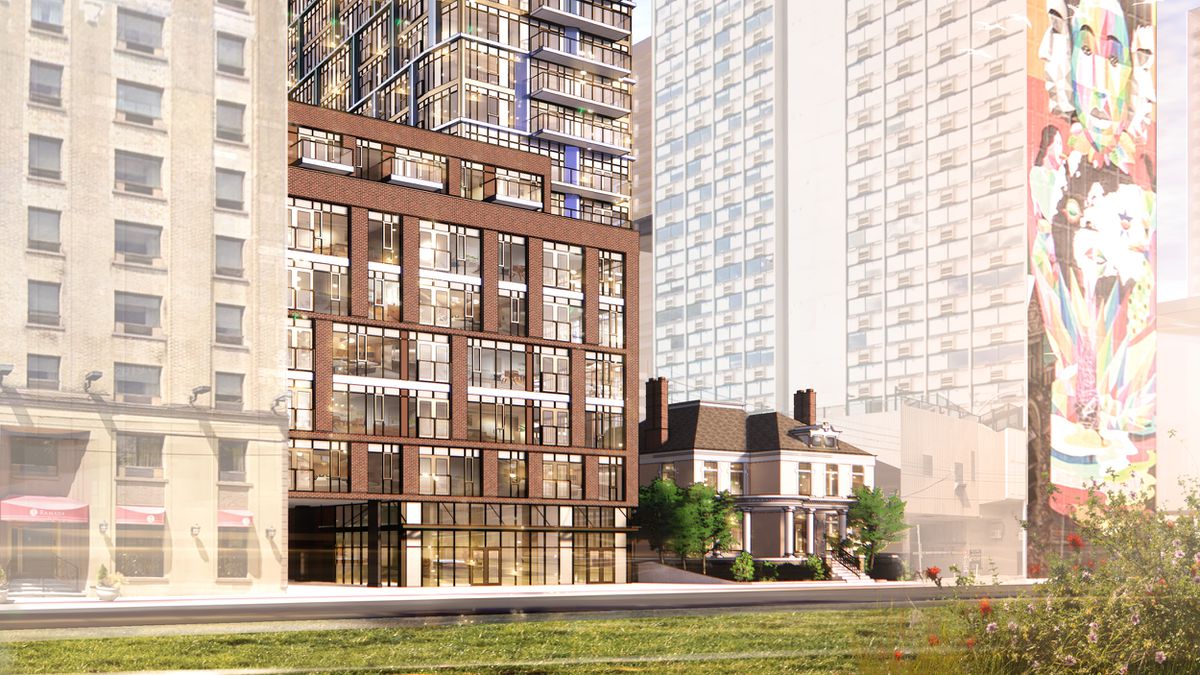On Labour Day weekend in 2019, a heritage house at 314 Jarvis St., in Toronto caught fire. It looked like Neil Pattison’s plan to combine the historic site with a new development had gone up in flames.
Just a few months earlier, Graywood and Phantom Developments had bought the mansion, built in the late 1800s. They planned to preserve it and build JAC Condos, a 34-storey residential building, behind it.
But as Graywood’s senior vice-president of development, Mr. Pattison was eager to save what little remained after the fire; two façades. The remnants were an “integral part of the redevelopment,” he says.
The surviving fragments of the heritage house are a reminder reminiscent of the street’s ritzy past. In the 1880s, Jarvis Street was the premier address in Toronto, a long tree-lined avenue of unattached, single-family mansions inhabited by the city’s business elite. But by the 1920s the neighbourhood had shifted. The previous generation having died off, the homes they left behind were too grand for most buyers and they were gradually converted, one by one, into boarding and rooming houses populated by young adults who were mainly clerks and salespeople.
Now, Jarvis Street anchors the eastern side of burgeoning Ryerson University. As the university expands and its campus population grows, ancillary development is again changing the face of the neighbourhood. Within a 15-minute walk of Ryerson, there are currently 35,000 housing units – a figure expected to nearly double in the next 10 years, according to the university’s master plan released in July.
In the past several years, three large condominium projects have put down roots around Jarvis and Dundas streets, just southeast of Ryerson’s campus, including, Dundas Square Gardens, Pace Condos and Grid Condos.
Meanwhile, the university’s population has doubled since 2008 to its current count of 45,000 students and is forecasting expanding to 60,000 in the long-term. Yet, there are only 1,153 beds on campus – enough for 2.5 per cent of the Ryerson student population.
The number of beds could soon increase to 1,742. This summer, the university submitted a rezoning application to the city for a 44-storey, 700,000 square foot tower at 202 Jarvis St., adding to the southeast quadrant’s growth.
“Ryerson is proposing, I think, probably the largest project that the university would ever undertake,” says Molly Anthony, Ryerson’s director of real estate.
The first 13 floors would be dedicated to classrooms and research laboratories while the remaining 29-storeys would be for residential use with over 500 dormitory-style beds and “hopefully a variety of price points,” says Ms. Anthony. The plans include 120 square foot “nano suites” with large amenity spaces to balance out the small personal spaces.
A Ryerson commissioned urbanMetrics study in 2019 found that there were nearly three times more condo units than purpose-built rentals in the vicinity of the university and the rent for condo units was on average 45 per cent higher than rental apartments.
“While this potential and significant intensification of the area provides additional stock,” Ryerson’s master plan reads, “affordability may continue to be a challenge in any new development if land and construction costs continue to rise along the same trajectory as the past decade.”
The push to increase the number of affordable beds on campus is a challenge for a growing urban community that’s landlocked and has a historic shortage of space.
Across Canada, campus housing is sparse. There are only 121,164 beds on university campuses, leaving demand in excess of 416,000, according to the Real Estate Investment Network’s (REIN) University Effect Report.
 314 Jarvis Street in the 1970s. The heritage house was built in the late 1800s.
314 Jarvis Street in the 1970s. The heritage house was built in the late 1800s.
The number of university students in Canada has increased, but so have government funding cutbacks, which has crimped the building of student housing. The REIN report makes clear there is increased demand, but little supply in the student-housing sector.
Some private developers have seen this as an opportunity.
“People are starting to notice the east side of the city,” says Jason Lam, CentreCourt’s vice-president of sales and marketing.
Over the past 10 years, CentreCourt has launched seven condominium buildings in Toronto’s east core – two of which are on Jarvis Street, with another situated between Church and Jarvis streets.
Mr. Lam comfortably estimates that, at minimum, Ryerson students and affiliates inhabit 25 to 50 per cent of buildings in the eastern core. In addition to the major advantage of developing near a university, proximity to Yonge St. and the subway are crucial features, too, he notes.
REIN’s University Effect Report, published in 2019, suggests that the presence of a university has a stabilizing effect on housing prices. It found that for every one kilometre a house is closer to a university, its price increases by one per cent.
The pandemic has shifted demand and created more risk, says Jennifer Hunt, REIN’s vice-president of research, because many students don’t have to be on-campus and there are far less international students than usual seeking housing. “Everything is stalled, but I believe that the demand will return,” Ms. Hunt says.
For her, tailoring strategically to a niche market is essential to mitigating risk, especially now. This includes identifying a particular university program and researching its duration and required in-class time, in order to effectively target students’ needs.
For example, Ms. Hunt has a student rental building in Abbotsford, B.C., that directly tailors to a four-year program for aircraft pilots – something that can’t be taught over Zoom.
Earlier this year, Graywood and Phantom Developments sat down with Ryerson architecture students to gain firsthand feedback on their JAC Condos designs. The goal was for students to shape the building, which is expecting occupancy in 2024.
Their insights led to plans for shared co-working spaces and study nooks, music and gardening rooms, a bar available for rent, rooftop patio and an arts and crafts area for school projects. Many units will have multiple bedrooms to accommodate roommates.
In the consultation, students also expressed the need for quiet space. Returning to Jarvis’ roots, the heritage house will be reconstructed and serve as a contemplative space for meditation and silent studying.
A two-storey glass corridor will attach the standalone mansion to the condominium – both literally and figuratively connecting the old Jarvis to the new.



